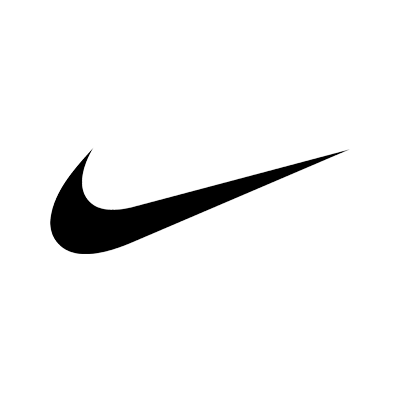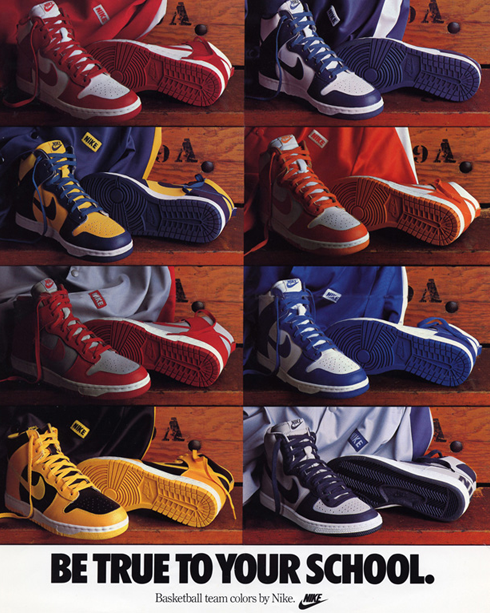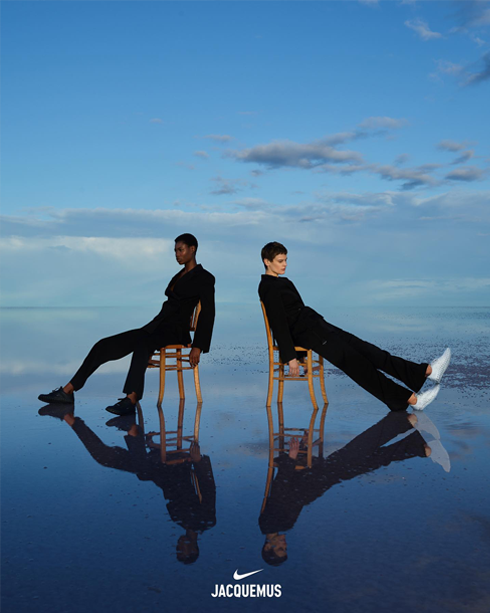Nike
Dunk
A beloved sneaker desired by millions.


Humble beginnings
In the mid-80s, along with his work on the Air Jordan I, designer Peter Moore was assigned to a project called “College Color High”. It was part of Nike’s College Colors program, through which they had officially partnered with teams in Division I of the National Collegiate Athletic Association’s basketball leagues to provide the players with shoes to train and compete in. Wanting to tap into the burgeoning college basketball scene of the time, Nike was keen to make an impression, so Moore and his team set about creating a trainer that would enhance player performance while also appealing to the sport’s growing fanbase. Thus began the story of the Nike Dunk; a remarkable story that continues to this day.

Be True to Your School
The Dunk came out not long after the Air Jordan I, in 1985, and was named after the famous dunk basketball shot, which had been popularised 40 years earlier by Olympic gold medal winner Bob Kurland. By the 80s, the slam dunk had become an integral part of the sport, making Dunk a great name for the shoe. Nike chose to launch it at the Final Four college finals – an event which generated incredible emotion and excitement. In fact, the passion shown by the players involved in this tournament formed part of the inspiration for the Dunk’s design. Back then, most basketball shoes came in solid blocks of colour, often all-white, but Nike decided to diverge from this common practice by creating seven different two-tone colourways released in the colours of each team. It was a smart move. Not only did it offer fans a sneaker with an appealing aesthetic, it also allowed them to show off their dedication to a particular college and the associated team. Knowing they were onto something good, Nike went all in on the idea, releasing the Dunk High under the memorable tagline “Be True to Your School”.

Building a basketball trainer
Design-wise, the Nike Dunk brought together three prior Nike silhouettes – the Jordan 1, the Terminator and the Legend. While the sneaker’s general shape was based on the Legend, the other two shoes inspired the appearance of the upper, with its stitched leather overlays and perforated toe box. Underneath, it featured a wedge midsole with a concentric gum outsole that offered players stability as they pivoted on the court. The look was completed with a padded ankle and tongue alongside unconventional eyestay positions for the laces. These were the latest developments in performance technology at the time, adding practical value to the fashionable aesthetic of the colour-blocked outer. However, despite being popular in its day as a basketball shoe, as the years wore on, more technologically advanced Nike models came out, eventually driving the Dunk off the court.

From basketball to skating
Through the late 80s and early 90s, as the shoe dropped in popularity, it became more accessible, remaining in the background but never falling away entirely. During this time, Nike made some simple changes to the Dunk, giving it a lightweight nylon tongue and a lower collar. These updates, allied with its thin, flat, grippy sole, ankle support and tough leather construction, just happened to make it perfect for the emergent skating subculture. As the Dunk became less commonplace in the mid- to late 90s, more skaters adopted the once popular basketball shoe, finding it a practical and affordable option.

The comeback begins
Nike had already tried to appeal to the skating world, achieving limited success, but as it became clear that the Dunk was a common choice in the community, the brand brought back the original Nike Dunk in 1998, 10 years after it had been taken off the production line. Soon, the Dunk began to make comebacks in different parts of the world. 1999 saw the arrival of the Dunk Low Pro B in California and the Dunk Low CO.JP in Japan. These low-top releases embraced the scene’s desire for self expression through unique customisations, with experimental colours, attention-grabbing patterns and novel textures alongside further padding for protection. Collaborations began to emerge too – 2001’s partnership with Stussy was particularly well-received. As sneaker fans caught on to the trend, some even went so far as to travel out to Japan to pick up the Low CO.JP.

A new design
In 2002, Nike established a dedicated skateboarding subdivision, Nike SB, with Sandy Bodecker appointed to run it. Fully aware of the Dunk’s ubiquity in the skate scene, Bodecker set out to craft a skating-specific Dunk that would really serve the community. Learning from the brand’s previous attempts to make a skating shoe, he decided to consult with the people who would hopefully choose to wear his design: the skaters themselves. He formed a sample based on the Dunk Low Pro B and presented it to skaters and skate shop owners, carefully listening to their feedback so that the sneaker could be adjusted to something they would want to wear.

Building trust
Bodecker’s hard work culminated in the introduction of the Nike SB Dunk in 2002. Its more skater-oriented design included a bulkier tongue, extra padding and Nike’s Zoom Air technology in the sole to provide high-quality cushioning. To make sure that the sneaker appealed to the skater community, Nike teamed up with four skaters – Danny Supa, Gino Ianucci, Richard Mulder and Reese Forbes. Each was given their own signature colourway, with the set being known as the “Colors By” series. They were only distributed to 12 carefully chosen local skate shops in limited numbers, a move which helped the stores to flourish, thus demonstrating Nike’s commitment to the scene and earning the trust of this tight-knit community.

Strong partnerships
Meanwhile, Nike was also beginning to harness the power of collaborations to generate hype for the new design. While partnerships with popular skaters worked wonders, it was the brand’s work with New York skate shop Supreme that really drove the SB Dunk forwards. The exclusive release proved to be a big success and led to further skate shop collaborations through the 2000s. One of those was the SB Dunk Low Pro x Staple Pigeon – a shoe which was so desired when it came out in 2005 that huge crowds gathered outside creator Jeff Staple’s Reed Space boutique in Manhattan to get hold of a pair. This drew enough attention to make the evening news, giving this famed sneaker even more hype.


A storied sneaker
While the Dunk’s popularity has fluctuated in the years since, it has never gone away. More than 35 years after it graced the courts of the college basketball leagues, this timeless model is still going strong thanks to re-releases such as the iconic Panda colourway and collabs like those with Off-White™ and Travis Scott. Every Nike Dunk design has its own story, whether it be connected to basketball, skating or fashion. With so many different iterations, some have become like rare pieces of art rather than trainers. Fundamentally, however, the Dunk remains a humble Nike shoe with incredibly broad appeal and a firm place in sneaker history.


